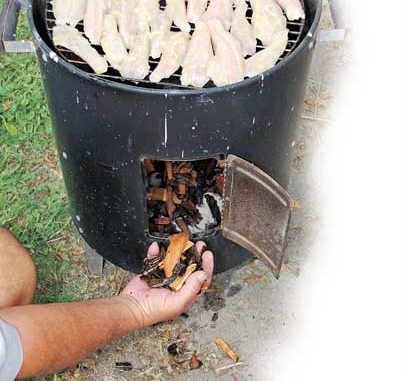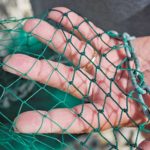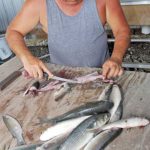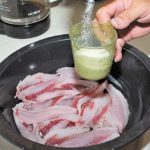
Think jumping mullet are only good to eat for trophy trout? Think again.
When I’m hungry for fish, I don’t care if the fish are hungry,” proclaimed John Supan with a puckish grin. “I love to hook-and-line fish sometimes, but throwing a recreational cast net is much more efficient. It’s fun, too.”
Supan, called Sup (pronounced Soup) by his friends and Dr. Supan by fisheries graduate students, is a research professor specializing in oyster culture and management with the Louisiana Sea Grant College Program. As director of the LSU Oyster Hatchery and research facility, Supan spends more than six months each year on Grand Isle.
Besides being the university’s premier oyster scientist and Louisiana’s unofficial oyster ambassador, Supan is a connoisseur of fine foods, especially those from the sea. Grand Isle has spoiled him. Millions of pounds of shrimp pour into the island, and the island provides the southern border of Barataria Bay, home of Louisiana’s famed Grand Lake oysters.
And it has fish, lots and lots of fish. It’s an island in a sea of speckled trout and striped mullet. For a month in the spring and then again another month in the fall, he puts a lot of mileage on his rods and reels, throwing topwater plugs at sow speckled trout. In between the seasons, his rods and reels reside in the closet.
“I’m just not interested in schoolies,” he states with no equivocation.
Between the two trout flurries, Supan chases mullet with his cast net.
The striped mullet, scientifically named Mugil cephalus, and in Louisiana commonly called popeye mullet, silver mullet or jumping mullet, is the most common of six mullet species found in the Gulf and Atlantic. It is a highly regarded food fish in Mississippi, Alabama and Florida, and is also eaten in Texas. Only in Louisiana, home to that race of people famous for eating anything, is the mullet scorned as food.
Supan developed his passion for sport fishing for mullet while working at the Gulf Coast Research Laboratory in Biloxi, Miss. According to Supan, use of the term “Biloxi Bacon” for smoked mullet dates back to the Great Depression of the 1930s, when Mississippians lived largely on mullet because they had no money and little food.
Smoked mullet was also eaten in Louisiana during the Depression, avers Supan. “Old timers”, who Supan loves to talk to, have told him that smoked mullet was locally called “Grand Isle bacon.” Smoked mullet, with its substantial oil content, does indeed taste similar to smoked pork. He adds that he has also heard that mullet, boiled with onions and potatoes, were consumed along Bayou Lafourche during Depression years.
Today, fried mullet, when in season, is a highly prized menu item in coastal Mississippi restaurants. Smoked mullet can also be purchased at various markets, and the fish is often smoked at home. Why the mullet fishing tradition died in Louisiana, Supan is unsure, but if he has his druthers, it will be resuscitated.
“It’s what men did and still do in Biloxi; they go to piers and cast net for mullet,” he said.
Native to West Virginia, where brook trout are scarce and a 12-incher is a whopper, the sight of men wading beach waters catching burlap sacks of fish amazed him.
“I gotta learn to do this,” he thought.
So he took a 12-week, $12 course on cast-net making and repair at the Biloxi Recreation Center in 1978. The course was good, but he still couldn’t throw a cast net properly. His eureka moment occurred on a Biloxi pier one day, when an old man, tired of hearing his complaints about his net not opening, looked at him in disgust and uttered three words, “Snap your wrist.”
“It’s a motion like throwing a Frisbee,” explained Supan.
Watching him throw a cast net from a pier now is a thing of beauty. His powerfully-built body snaps like a high-tensile steel spring released from compression, and the huge 8-foot-radius net appears to erupt from his clasp and spread like a giant flower as it drops in a near-perfect circle on the water.
The sport is not just in the perfect pairing of the man and the tool, though.
“Mullets are wary and have extremely good eyesight,” says Supan “and they will run from the shadow of a thrown cast net. You’ve got to stalk them and outwit them.”
And so he does, moving quietly and deliberately on the piers on the bay side of Grand Isle, behind and near the oyster hatchery. His eyes are constantly scanning the water for signs of the fish. When he sees what he’s looking for, he throws the net to where his mental calculation tells him the fish will be when the net drops. He also ambushes them by hiding in the shadows of a camp built on pilings out over the water. As the wary fish approach the camp, they swing out just wide enough to pass outside the camp’s shadow. At the right moment he shoots the net out of the shadow to ensnare them.
A favored time to fish is when the tide is high and a big tide range induces the mullet to travel near the island shore through the piers. With a high tide up to the stringers of the piers, the surface-swimming fish must dive to pass under a pier. Underwater, they can’t see as well, and the pier itself interferes with their vision as well. As they surface on the other side of the pier, they are easy marks for Supan’s cast net.
But today the tide range is weak and the mullet are scattered, forcing Supan to work hard for each fish. After the mullet become wary enough to avoid the piers he is on, Supan eases into the waist-deep water, and silently stalks the fish. Because he is half-submerged, he swaddles the large cast net over and around his body like the wrappings of a mummy. It appears impossible to throw, but throw it he does, gracefully and accurately. The fish go in a burlap sack hung across his shoulders.
When he has enough fish, he hustles to a work table and begins filleting. As he fillets, he shows me the “blood line,” a thin skein of red flesh on the side of the fillet where the skin was attached.
“The color of the blood line,” he says “determines the quality of the flesh. As long as it is red, the fish will be delicious, but once it degrades to brown, the flesh will become unappealingly fishy-tasting.”
Filleting, he says, is not the typical way of preparing mullet for smoking in Mississippi, where more often the fish are scaled and the bone is left in.
“When I’m eating fish, I don’t want to mess with bones,” he said. “It slows me down too much.”
He does admit, however, that leaving the bone adds a lot of flavor.
He also notes that if he were cleaning the fish for frying, he would keep their gizzards, which have the same function for a fish as for a chicken. About the size of the last joint of a person’s thumb, the gizzards taste much like the flesh of the fish, but are chewier.
“They can be as habit forming as popcorn,” he says.
He instructs that gizzards must be rolled in something sticky, like mustard, before breading, or the corn meal won’t stick to them. The one thing he doesn’t eat from a mullet are the roe sacks, which he declares are “too bland.”
The short shelf life of mullet, two days, even if properly refrigerated, is what pushed Supan to begin smoking much of his burgeoning catches.
“I can hold smoked mullet three weeks under refrigeration,” he said. “I munch on it all day, and I carry pieces of it in my shirt pocket while I work at the oyster hatchery.
“I do other things with smoked mullet too. I make salads, I flake the meat to make omelets and you’ve never lived until you’ve eaten Dr. Sup’s mullet sandwich. I criss-cross smoked mullet fillets in two or three layers and lay a slice of Swiss cheese on top. Then I microwave it until the cheese is barely melted and set the stack in a toasted sesame-seed bun dressed with leaf lettuce, mayo and horseradish.”
Supan grins broadly. His irrepressible good nature is contagious.
While the fish are smoking, Supan talks about his cast net.
“Most cast nets used by Louisiana sportsmen are bait nets,” he said. “They have a small radius, small meshes and are made with machine-made webbing. Machine-made meshes, whether nylon or monofilament, will slip and distort under strain. They are made to be inexpensive and disposable.”
Hand-made nets such as his have hand-tightened nylon knots that never slip. Typical Mississippi mullet cast nets have a mesh size of 2 inches (stretched measure). The large meshes cast less of a fish-scaring shadow and sink faster than small-mesh nets, preventing the evasive mullets from swimming out from under the net. Because Supan enjoys cast netting for shrimp as well as mullet, he has compromised his mesh size at 1¼ inches stretched.
Supan’s net also follows Mississippi tradition in that he uses small chain to weight the edges of the net rather than lead weights. Chain throws better than lead weights, and “it sings when you throw it,” he said.
Hand-made, large-mesh nylon cast nets such as his can be hard to find in Louisiana. Supan found a net-maker by questioning bayou hardware store owners.
“Expect to pay about $250 for hand-made, 8-foot-radius cast nets,” he said.
He encourages people who don’t want to invest in a top-quality net to use their smaller bait cast nets. Access to piers located in water less than 6 feet deep makes mullet fishing easier. Cast netting by standing on the bow of a boat can be very effective, but demands a good helmsman to keep the boat off the net and the caster standing upright.
Supan notes that one of the very best times to catch mullet is coming up soon. In September, mullet mass in large numbers in Louisiana’s lower bays in preparation for their 40-mile run offshore to spawn.
“You can really slay ’em in the early fall,” he says with a devilish grin.
One piece of cautionary advice he offers for those new to recreational mullet fishing is to avoid catching mullet to eat from fresh water.
“They have a musty taste, nothing like the rich nutty taste of saltwater mullet,” he said. “I would also encourage people to try frying freshly caught mullet. They are wonderful. My family loves it when I go out early and catch and clean a mess of mullets before full light. Fresh fried mullet, grits, homemade biscuits and fried eggs are their favorite breakfast.”
Louisiana law allows the use of recreational cast nets with a radius of up to 8 feet, 6 inches under the basic and saltwater recreational licenses. Daily take and possession limits are a generous 100 pounds of mullet per person per day. No minimum or maximum sizes are in effect.








